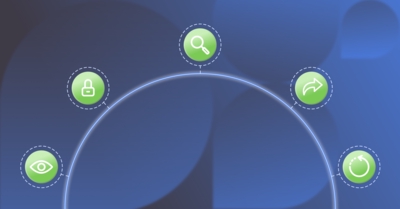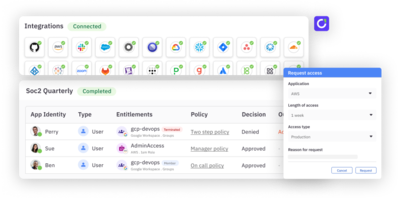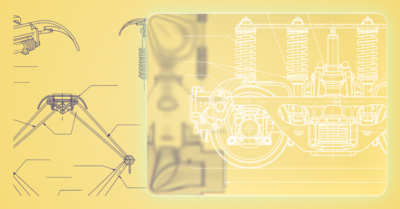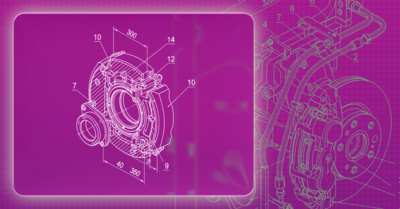In February 2024, the National Institute of Standards and Technology (NIST) released the updated Cybersecurity Framework (CSF) 2.0, a comprehensive guide for managing and mitigating cybersecurity risks. Understanding NIST CSF 2.0 helps you reduce risk exposure, meet regulatory requirements—such as HIPAA, and PCI DSS—and improve your company’s security posture, especially through enhanced identity and access management (IAM). CSF 2.0’s structured guidance enables teams to manage access rights effectively, protect sensitive data, and prevent unauthorized access, boosting resilience and compliance while building customer trust.
NIST CSF 2.0 is based on six main functions:
Govern: Define and oversee the organization’s cybersecurity risk management strategy, ensuring alignment with broader enterprise risk management goals and stakeholder expectations.
Identify: Gain visibility over assets, data, and risks to prioritize protection efforts effectively.
Protect: Implement safeguards like access controls and security policies to prevent unauthorized access.
Detect: Use monitoring systems to quickly identify threats and detect incidents in real time.
Respond: Define actions for effective containment and mitigation when an incident occurs.
Recover: Establish recovery strategies to minimize downtime and swiftly resume operations.
This article serves as a guide to applying the NIST CSF 2.0 framework within the scope of IAM, detailing how each of the five key goals can enhance IAM practices and strengthen organizational cybersecurity.
Govern
The “Govern” function was introduced in NIST CSF 2.0, reflecting the growing importance of aligning cybersecurity with an organization’s broader enterprise risk management (ERM) strategy. It serves as an overarching element that integrates with and supports the other five functions—Identify, Protect, Detect, Respond, and Recover—ensuring they align with organizational objectives and risk management priorities.
Adding the Govern function addresses gaps in the earlier version of NIST CSF by integrating governance into the framework’s foundation. Governance defines the organization’s cybersecurity risk management strategy, including key elements such as roles, responsibilities, policies, and oversight. While governance includes aspects like IAM, it extends beyond access control to encompass the broader alignment of cybersecurity practices with the organization’s mission and stakeholder priorities. This structured approach ensures more effective management of cybersecurity risks across all levels.
Identify
A clear understanding of user roles and specific access needs is essential for effective IAM. Categorizing users based on roles and responsibilities and assigning permissions that align directly with job functions reduces the risk of overprivileged accounts. Limiting access to what is necessary strengthens security by ensuring users interact with only the systems and data essential to their roles.
In other words, it helps properly address the following questions:
- Who exactly needs access to what?
- Is that access specifically tied to their job functions?
- Are their permissions effectively adhering to the principle of least privilege?
To answer these questions, you must have an accurate inventory of all systems and resources for effective IAM management. With a complete inventory, you can clearly determine who should have access to which resources based on the specific needs tied to their job functions. This approach not only answers those key questions around access but also reinforces the principle of least privilege. If you understand exactly what systems and data are in place and map access to them accordingly, you can then ensure permissions are tightly controlled, minimizing unnecessary exposure and enhancing security.
After establishing a clear overview of your systems and resources, the next step is to map IAM policies to risk profiles, aligning permissions with each role’s risk level. This lets you consider data sensitivity and the potential impact of misuse, so users with higher risk have stricter access controls. This enables you to reduce exposure and keep security measures tightly aligned with your organization’s needs.
Protect
Once you have comprehensive visibility over your inventory, the next goal is to implement effective protection measures. You protect your assets from cybersecurity threats by setting and enforcing controls, and which controls you use depends on your use case. As this article focuses on IAM, the controls discussed are directly related to identity protection.
Attackers seek the path of least resistance by exploiting weak spots and misconfigurations to infiltrate target organizations quickly. Uninformed, nontechnical end users often present vulnerabilities, making them easy targets and the weakest link in the cybersecurity chain. Enabling multi-factor authentication (MFA) can help to secure this link by adding an extra layer of security and reducing the risk of breaches that rely solely on compromised credentials. Credentials are easy to steal through phishing attacks, but with MFA, the attacker will need an additional means of authentication, which only the end user possesses (like a cell phone with an MFA app or a YubiKey). This results in a failed breach attempt.
MFA is a key protection strategy that not only strengthens IAM security but also has measurable KPIs, such as adoption rates or reduction in successful unauthorized access. This metric-driven approach enables you to track the effectiveness of MFA implementation in reducing risk and reinforcing access controls. To maximize the security of MFA, advanced techniques such as phishing-resistant authentication are essential, as traditional methods like email-based authentication are more prone to compromise.
While MFA strengthens authentication, enforcing the principle of least privilege further reduces risks by ensuring users and applications only have access to what is absolutely necessary for their roles. However, achieving least privilege effectively requires more than just strong authentication—it demands Identity Governance and Administration (IGA) to manage access rights and minimize security gaps.
IGA tools automate identity lifecycle management to ensure users’ access rights align with their current roles and responsibilities, reducing standing privileges and preventing overprovisioning. Additionally, features like just-in-time (JIT) access and automated user access reviews (UARs) help organizations dynamically grant temporary access when needed and routinely audit access to identify and remediate risky permissions.
Detect
In cybersecurity, prevention is the best defense. Effective prevention requires robust detection mechanisms that identify potential threats early, allowing you to stop attacks before they can cause harm. As part of an effective detection strategy, users need to be monitored to ensure secure interactions with company resources. Tracking their activities on company-provided devices helps detect unauthorized access, protect sensitive data, and prevent potential breaches, whether they’re handling client data, cloud resources, code, or other critical assets.
Systems like user and entity behavior analytics (UEBA) use AI and machine learning to understand a user’s typical interactions with resources, locations, and working hours—for example, activity patterns between 8 a.m. and 5 p.m. ET. Any deviations from these expected behaviors are flagged and, when configured properly, can trigger alerts to the appropriate team for investigation and resolution.
Logging is essential for identifying unusual user activities that may signal a security threat. Access logs provide a comprehensive view of each user’s permissions and enable detailed analysis of their access levels. Meanwhile, audit logs allow you to trace the actions taken by a compromised user account, revealing exactly what the attacker did after gaining access.
Aside from UEBA, correlating this logged data with events is also a good practice. Tools like SIEMs and SOARs facilitate this by linking logs with predefined security events or patterns, such as unusual login locations or access times that might indicate a policy violation. When these tools detect suspicious activity, they generate alerts or incidents, allowing you to respond quickly. Their automation capabilities can make all the difference in blocking an attack before it escalates to data exfiltration (exposure) or significant impact.
Respond
Once you’ve detected an attack, you need to respond effectively. Incident response is all about being well prepared for potential scenarios. Clear protocols are essential when user compromise is suspected to ensure that potential threats are rapidly identified and contained. Measuring metrics such as Mean Time to Detect and Mean Time to Respond (MTTD and MTTR) helps quantify the efficiency of your incident response plan, enabling your organization to track performance and make data-driven improvements before establishing specific actions, such as immediate account suspension, verification procedures, and system audits. This enables a quick, organized response that minimizes damage.
Just as accidents are inevitable, so too are breaches, which often occur on a scale you might not anticipate. In these cases, having a solid incident response plan in place is essential to counterattack a breach compromising IAM. This plan should outline clear steps for containment, investigation, and recovery, ensuring a fast, organized response to limit damage. A prepared response framework enables your team to act immediately to contain breaches and restore secure access efficiently, as well as lock down critical assets like your clients’ Personally Identifiable Information (PII) or source code that could pose irreparable damage if leaked.
Communication is key, and if a breach occurs, the best course of action is to immediately inform stakeholders on the current events. In addition, any system or resource not covered by IAM policies should be added to a risk register to keep stakeholders aware of potential vulnerabilities. This register serves as a central record of risks and documents any gaps in IAM coverage, along with their potential impact and planned mitigation strategies. Keeping stakeholders informed through this structured approach ensures that risks are clearly understood and prioritized.
Recover
Sometimes, despite ample precautions and good practices, a breach will happen. So, what can you do in these cases? In cybersecurity, this is called recovery, and it refers to the process of restoring normal operations and minimizing damage following a breach or incident.
Even when it’s hard to foresee the implications of a scenario whose outcome you don’t know about yet, you can still design a procedure to quickly and securely restore access after a widespread breach to resume normal operations. This process should include verifying user identities, resetting compromised credentials, and reviewing access levels to ensure permissions are properly aligned, all in a timely manner. Establishing a clear Recovery Time Objective (RTO)—the maximum tolerable downtime after an incident—ensures your organization can prioritize resources effectively to meet operational demands during recovery. This will prevent further unauthorized activity and minimize operational downtime.
In addition, understanding the factors that led to a breach is the foundation of a hardened and more resilient organization. Analyzing these incidents highlights weaknesses in the current cybersecurity posture and reveals necessary mitigations to better protect against future risks.
Conclusion
The NIST Cybersecurity Framework (CSF) 2.0 is a powerful tool for managing cybersecurity risks through its core functions: Govern, Identify, Protect, Detect, Respond, and Recover. Applying these principles to your identity and access management (IAM) posture strengthens access security and reduces potential vulnerabilities and risks. Each CSF goal, from assessing your asset inventory to implementing access controls, monitoring user behavior, and preparing for breaches, will pave the way towards a resilient cybersecurity stance. For more details on the NIST CSF 2.0 and additional information and references, check out the official documentation.
ConductorOne is a modern identity governance platform that can help you align with the NIST CSF 2.0. It centralizes access control, automates access reviews, and enforces the principle of least privilege through features like just-in-time provisioning and self-service access. This reduces the risks associated with standing privileges and overpermissioned accounts, which are factors that NIST CSF 2.0 addresses in its focus on access management and resilience. ConductorOne streamlines access control and reduces manual tasks, reinforcing a zero trust model that aligns with the CSF’s goals for secure and efficient access governance.




